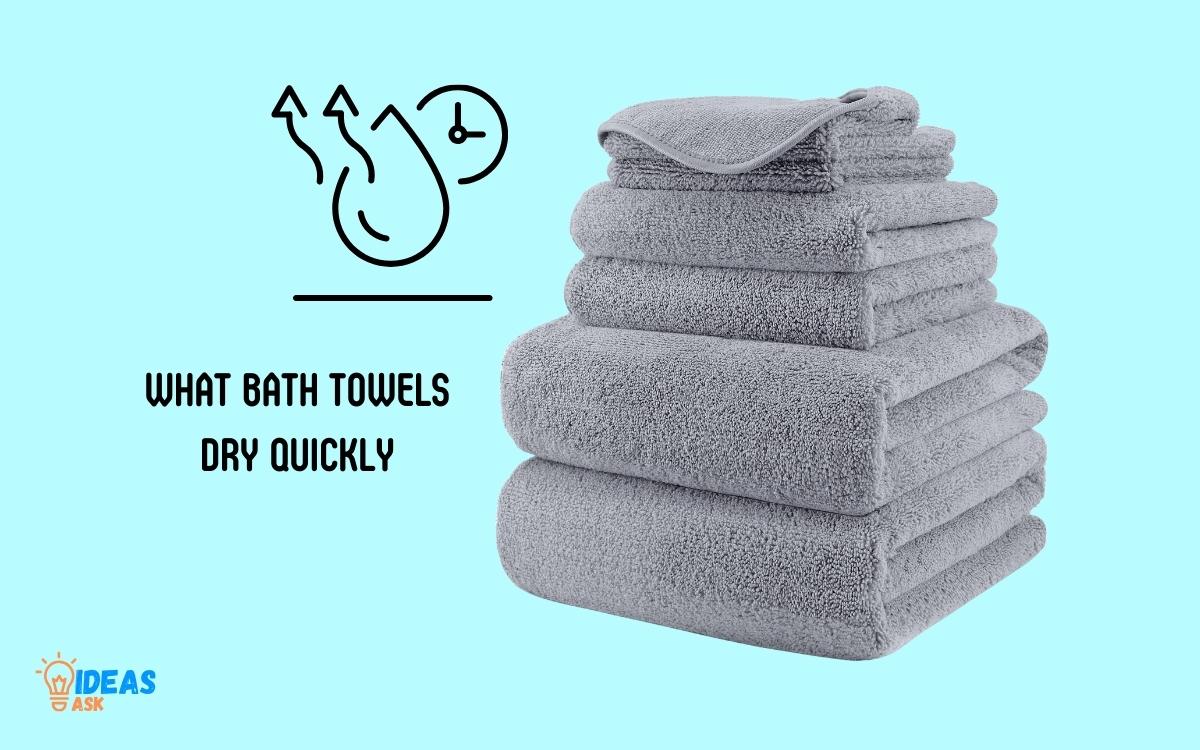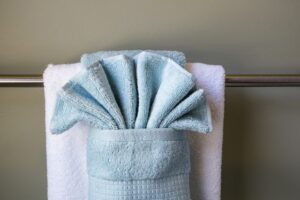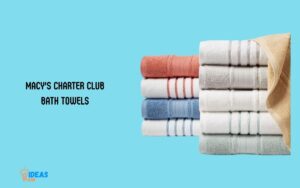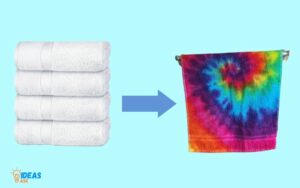What Bath Towels Dry Quickly? Find Out!
Microfiber and Turkish cotton bath towels are popular options that dry quickly. Towels made from microfiber or Turkish cotton are known for their quick-drying properties. This is due to the specific properties of these materials.
Microfiber has fine threads which facilitate fast water absorption and evaporation, leading to quick drying. Turkish cotton, on the other hand, is lightweight and highly absorbent, making it easy to dry as well.
Microfiber and Turkish cotton bath towels have quick-drying capabilities that make them ideal for various uses.
Whether for travel, sports, or daily home use, these towels can be easily and quickly dried, making them a convenient option. Besides, their lightweight nature adds to the convenience.
Proper care, including regular washing and avoiding fabric softeners, can further enhance their quick-drying attributes.

Key Takeaway
How Does The Fabric Composition Affect Drying Time?
The composition of bath towels can greatly impact their drying time. Fabrics like microfiber, bamboo, or quick-drying blends tend to dry faster compared to heavier materials like cotton.
Cotton:
- Renowned for its softness and absorbency, cotton towels have been a popular choice for years.
- Cotton towels efficiently absorb moisture, making them ideal for drying off after a bath or shower.
- The natural fibers in cotton towels allow for increased airflow, which aids in quick drying.
- The absorbent nature of cotton allows it to retain moisture, which can extend the drying time.
Microfiber:
- Made from synthetic materials such as polyester and nylon, microfiber towels are known for their exceptional absorbency.
- Microfiber towels can hold up to seven times their weight in water.
- The ultra-fine fibers of microfiber towels increase the surface area, allowing for faster absorption and evaporation of moisture.
- The high-density construction of microfiber towels promotes quick drying by trapping air between the fibers.
The impact of weave and thread count on drying efficiency.
Weave:
Towels are typically woven in two main styles:
- Terry cloth and flat-weave.
- Terry cloth towels have loops on both sides, providing extra surface area for moisture absorption.
- The loops in terry cloth towels also increase the drying time as they take longer to dry.
- Flat-weave towels, on the other hand, have a smoother surface and tend to dry more quickly.
Thread count:
- Thread count refers to the number of threads per square inch of fabric.
- Higher thread count towels generally have a denser weave, which can affect drying time.
- Towels with a lower thread count often dry faster as they allow for better airflow, leading to quicker evaporation of moisture.
- However, towels with a higher thread count may feel softer and more luxurious.
The fabric composition, including the choice between cotton and microfiber, as well as the weave and thread count, all play significant roles in the drying efficiency of bath towels.
While cotton towels offer excellent absorption and airflow, microfiber towels excel in their ability to quickly absorb and release moisture.
Furthermore, selecting a towel with a flat-weave and lower thread count can contribute to faster drying times.
Ultimately, understanding these factors can help you choose bath towels that dry quickly, providing a comfortable and efficient drying experience.
Innovations In Towel Technology For Faster Drying
Discover the latest advancements in towel technology designed for quicker drying. Experience the convenience of bath towels that efficiently absorb moisture, ensuring a fast and comfortable drying experience.
Exploring The Benefits Of Fast-Drying Materials Such As Bamboo Or Linen:
Bamboo towels
Known for their exceptional absorption properties, bamboo towels can absorb moisture quickly, allowing them to dry faster than traditional cotton towels.
The bamboo fabric is lightweight and breathable, promoting quick evaporation, which helps to accelerate the drying process. Additionally, bamboo towels are hypoallergenic and naturally resistant to odors and bacteria.
Linen towels
Linen is another great option when it comes to fast-drying towels. Linen fibers have excellent moisture-wicking capabilities, allowing them to absorb water efficiently.
This natural material also dries quickly due to its high breathability and superior airflow. Linen towels are highly durable, making them perfect for everyday use.
High-Performance Synthetic Fabrics That Promote Quick Evaporation:
Microfiber towels
Made from ultra-fine synthetic fibers, microfiber towels are designed to quickly absorb and evaporate moisture. These towels have a high surface area, allowing them to hold more water than regular towels.
The tiny fibers in microfiber towels trap moisture effectively, promoting rapid evaporation and faster drying times.
Polyester towels
Polyester is a synthetic fabric commonly used in towels due to its ability to dry quickly. The hydrophobic nature of polyester repels water, enabling it to evaporate quickly.
Polyester towels are lightweight, soft, and durable, making them ideal for those seeking fast-drying options.
How Nanotechnology Is Revolutionizing Towel Drying Speed:
Nanotowels
Nanotechnology has introduced an innovative solution to towel drying speed with the development of nanotowels. These towels are treated with microscopic particles that increase surface area, enhancing their absorbency and quick-drying capabilities.
Nanotowels have the ability to remove moisture efficiently without leaving any residue behind. This cutting-edge technology is revolutionizing the towel industry by significantly reducing drying times.
Hydrophobic coatings
Nanotechnology has also led to the development of hydrophobic coatings that can be applied to towels. These coatings create a barrier that repels water, preventing moisture from being absorbed by the towel fibers.
As a result, towels with hydrophobic coatings dry much faster than traditional options. This revolutionary technology enhances both absorption and drying efficiency.
Innovations in towel technology have transformed the way we approach drying tasks. Whether it’s utilizing fast-drying materials like bamboo and linen or embracing synthetic fabrics engineered for quick evaporation, there are plenty of options available.
Additionally, nanotechnology has paved the way for even faster drying times by introducing nanotowels and hydrophobic coatings.
With these advancements, you can enjoy the luxury of using a towel that not only absorbs moisture efficiently but also dries in a fraction of the usual time.
Factors Influencing Towel Drying Time
Factors such as fabric type, fiber quality, and towel thickness greatly influence how quickly bath towels dry. These factors affect the towel’s absorption capacity and airflow, leading to varying drying times.
Thick and dense towels may feel luxurious, but when it comes to drying time, thinner towels take the lead.
Here’s why:
Thickness And Density: Why Thinner Towels Tend To Dry Faster.
- Less material to hold moisture: Thin towels have a lower capacity for water absorption due to their lighter weight and thinner fabric composition. This means that they can dry faster as there is less moisture to evaporate.
- Improved air circulation: The thinner the towel, the easier it is for air to circulate through its fibers. This enhanced airflow promotes quicker evaporation, resulting in faster drying times.
- Less surface area for moisture retention: Thinner towels typically have a smaller surface area compared to their thicker counterparts. This means they have less space to trap moisture, enabling them to dry more efficiently.
Aren’t limited to thickness and density alone. Another key aspect to consider is absorbency:
The Role Of Absorbency In Determining Drying Efficiency.
- High absorbency = longer drying time: Towels with high absorbency are efficient at soaking up moisture but may take longer to dry. This is because they retain a significant amount of water within their fibers, requiring more time for evaporation.
- Quick-drying materials: Some towels are specifically designed with quick-drying materials, such as microfiber or bamboo fabrics. These materials have excellent moisture-wicking properties, allowing them to absorb and release water more rapidly, resulting in faster drying times.
Towel size and surface area also play a role in determining drying time:
The Effect Of Towel Size And Surface Area On Drying Time.
- Larger towels take longer to dry: The bigger the towel, the more area it occupies, which means more moisture retention. Larger towels have a greater amount of fabric to dry, increasing the drying time compared to smaller towels.
- Increased surface area = improved drying: Towels with texture, like ribbed or waffle-weave patterns, have a larger surface area. This expanded surface area allows for more efficient evaporation, consequently reducing drying time.
When it comes to quick-drying towels, choosing thinner, less dense towels with lower absorbency and considering towel size and surface area can significantly impact drying time. So, next time you’re in search of a towel that dries in a flash, remember these factors.
Happy towel shopping!
Considerations For Material Selection
Selecting the right material for bath towels is crucial for quick drying. Choose towels made from absorbent fabrics like microfiber or bamboo to ensure fast and efficient drying after use.
Consider the following aspects when choosing a material:
- Climate: If you live in a humid environment or have limited air circulation in your bathroom, opt for towels that dry quickly to prevent stale odors and mildew growth.
- Personal preference: Assess your priorities and decide whether absorbency or quick drying is more important to you. This can help guide your material selection.
Comparing The Advantages And Disadvantages Of Different Fabric Options:
When comparing different fabric options for bath towels, it’s essential to consider the advantages and disadvantages.
Here are some key points to keep in mind:
Cotton towels:
- Advantages: Exceptional absorbency, soft and plush texture, widely available.
- Disadvantages: May take longer to dry, potential for lint shedding.
Microfiber towels:
- Advantages: High absorbency, quick drying, lightweight and compact, ideal for travel.
- Disadvantages: Less luxurious feel compared to cotton, may not be as durable.
Bamboo towels:
- Advantages: Eco-friendly, excellent absorbency, soft and hypoallergenic.
- Disadvantages: Potential for shrinkage if not cared for properly.
Linen towels:
- Advantages: Good balance of absorbency and quick drying, lightweight and breathable.
- Disadvantages: Prone to wrinkles, may feel slightly rough initially.
Turkish cotton towels:
- Advantages: Luxurious feel, high absorbency, durable and long-lasting.
- Disadvantages: Slightly slower to dry, may be more expensive.
Synthetic blends:
- Advantages: Quick drying, moisture-wicking properties.
- Disadvantages: Less absorbent, may not be as soft.
Consider your personal preferences, budget, and specific needs when weighing the advantages and disadvantages of each fabric option.
Environmental Impact: Are Eco-Friendly Materials Also Quick-Drying?
Considering the environmental impact of bath towels is essential for eco-conscious individuals. The good news is that eco-friendly materials can also possess quick drying capabilities.
Here are some eco-friendly options to consider:
- Organic cotton: Towels made from organic cotton are sourced from crops grown without the use of pesticides or other harmful chemicals. They offer the same absorbency as regular cotton towels but may take slightly longer to dry.
- Bamboo: Bamboo towels are a sustainable choice as bamboo is a highly renewable resource. These towels are known for their excellent absorbency and often dry faster than cotton towels.
- Hemp: Hemp towels have gained popularity due to their eco-friendly properties. Hemp crops require minimal water and pesticides to grow and produce highly absorbent towels that dry quickly.
- Recycled materials: Towels made from recycled materials, such as recycled cotton or plastic bottles, are another eco-friendly option. They can possess quick drying capabilities while reducing waste and conserving resources.
When selecting eco-friendly towels, consider certifications such as Global Organic Textile Standard (GOTS) for organic materials or certifications for recycled materials.
These ensure that the towels meet specific environmental standards while still offering functional benefits.
Practical Features To Look For In Fast-Drying Towels
Look for practical features like microfiber material and double-stitched hems that contribute to fast-drying towels.
These towels are designed to absorb moisture quickly, making them perfect for busy individuals on the go.
Towels are an essential item in any bathroom, and finding one that dries quickly can save you time and energy.
When shopping for fast-drying towels, there are a few practical features to consider. Whether it’s special finishes or treatments, towel designs with built-in ventilation or moisture-wicking properties, or evaluating thickness and weight, these factors can greatly enhance the towel’s drying speed.
Special Finishes Or Treatments That Enhance Drying Speed:
- Hydrophobic finish: A hydrophobic finish repels water, allowing the towel to dry faster by preventing it from absorbing moisture.
- Microfiber technology: Towels made with microfiber materials have ultra-fine fibers that increase surface area, leading to better absorption and faster drying.
- Anti-microbial treatment: Towels with an anti-microbial treatment inhibit the growth of bacteria and mold, preventing odors and prolonging freshness between washes.
- Quick-dry coating: Some towels are treated with a quick-dry coating that helps water evaporate more quickly, reducing drying time.
Quick-Drying Towel Designs With Built-In Ventilation Or Moisture-Wicking Properties:
- Mesh panels: Towels with mesh panels allow for increased airflow, promoting quicker drying by allowing moisture to evaporate more easily.
- Open-loop or waffle weave: These designs create air pockets within the fabric, enhancing ventilation and facilitating faster drying.
- Quick-drying fibers: Towels made from quick-drying fibers such as bamboo or linen have natural moisture-wicking properties, absorbing and releasing water more efficiently.
Evaluating Towel Thickness And Weight For Optimal Drying Performance:
- Opt for thinner towels: Thin towels generally dry faster since they have less material to hold onto moisture. Look for towels with a lower GSM (grams per square meter) for quicker drying.
- Lightweight towels: Towels made with lightweight materials, like Turkish cotton or microfiber, tend to dry faster due to their low mass and increased breathability.
- Avoid overly plush towels: While plush towels are luxurious and soft, they can also take longer to dry due to their dense fabric and high absorbency.
Consider these practical features when searching for fast-drying towels to ensure that your towel not only absorbs moisture efficiently but also dries in no time.
By choosing a towel with special finishes or treatments, innovative designs with ventilation, or evaluating the thickness and weight, you’ll be one step closer to enjoying a quick-drying towel experience in your daily routine.
Proper Washing Techniques For Quick-Drying Towels
Learn the proper washing techniques for quick-drying towels, ensuring that they’re ready for use in no time. These tips will help you maximize towel absorbency and keep them fluffy and soft.
Proper washing techniques not only help maintain the quality of your towels but also contribute to their quick-drying properties.
Here are some tips to follow:
- Use a gentle detergent: Opt for a mild detergent that is specifically formulated for delicate fabrics. Harsh detergents can leave residues that reduce towel absorbency and prolong drying time.
- Avoid fabric softeners: Fabric softeners can create a coating on the towels, making them less absorbent and slower to dry. Instead, use white vinegar in the final rinse cycle to help soften the fibers without leaving any residue.
- Wash towels separately: Washing towels with other fabrics, like clothing or bedding, can result in lint transfer that not only affects absorbency but also increases drying time. Wash towels separately to prevent this issue.
- Choose the right water temperature: Hot water may seem like a good idea for cleaning towels thoroughly, but it can damage the fibers and reduce absorbency. It’s best to wash towels in warm or cold water.
- Avoid overloading the washing machine: Overloading the washing machine can hinder the proper circulation of water and detergent, resulting in ineffective cleaning and longer drying times. Follow the machine’s capacity guidelines.
By following these proper washing techniques, you can ensure that your bath towels remain absorbent and dry quickly, enhancing your overall bathing experience.
Drying Methods That Speed Up The Drying Process
Discover the secrets to faster drying bath towels with these innovative drying methods. From using high-quality microfiber towels to utilizing efficient towel wringing techniques, learn how to have your towels ready in no time.
When it comes to bath towels, one thing we all desire is for them to dry quickly. Nobody wants to use a damp towel after a refreshing shower. Fortunately, there are several drying methods that can help speed up the drying process.
Air Drying Vs. Machine Drying: Determining The Fastest Option
Air drying and machine drying are two common methods for drying bath towels. Let’s take a look at both options to determine which one is the fastest:
Air drying:
- Hang the towel on a clothesline or towel rack to allow for maximum airflow.
- Make sure the towel is spread out evenly to ensure even drying.
- Ideal for warm and breezy weather conditions.
- Can take longer compared to machine drying.
Machine drying:
- Set the dryer to a high heat setting for faster drying.
- Toss in a clean, dry towel to help absorb moisture and speed up the process.
- Suitable for all weather conditions, especially during colder months.
- Generally faster than air drying.
If you are looking for the fastest option, machine drying is the way to go. However, if time permits or if you prefer environmentally friendly options, air drying can also be effective, although it may take longer.
Utilizing Towel Hooks And Racks For Increased Airflow During Drying
To optimize the drying process and make your towels dry faster, consider utilizing towel hooks and racks. These can help increase airflow and prevent dampness.
Here are some tips for utilizing towel hooks and racks effectively:
- Install multiple towel hooks or racks in your bathroom or laundry area to maximize drying space.
- Ensure the towel is unfolded and spread out evenly on the hook or rack for better airflow.
- Place the hook or rack in a well-ventilated area to speed up drying.
- Avoid crowding towels on a single hook or rack, as this can hinder airflow.
By using towel hooks and racks strategically, you can enhance the drying process and enjoy fluffy, dry towels in no time.
Alternatives To Traditional Drying Methods For Quick Results
If you’re in a hurry or want to try alternative methods, here are a few options that can provide quick drying results:
Hairdryer:
- Set your hairdryer to the highest heat setting.
- Hold the hairdryer a few inches away from the towel while continuously moving it around.
- Be cautious, as excessive heat may damage delicate towels, and always follow the manufacturer’s guidelines.
Towel warmer:
- Invest in a towel warmer, which provides a controlled environment for drying towels.
- Simply place the towel on the warmer and let it do its job.
- Ideal for those who want a warm and dry towel immediately after a shower.
Sun drying:
- On a sunny day, lay your towel flat outside in direct sunlight.
- Ensure the towel is fully stretched out to maximize surface area exposure.
- The sun’s heat and UV rays will help evaporate the moisture from the towel.
These alternative drying methods offer quick results, but it’s important to consider their suitability for your specific towel material and personal preferences.
By understanding the different drying methods available and implementing strategies like air drying, machine drying, utilizing towel hooks and racks, or exploring alternative methods, you can ensure your bath towels dry quickly and efficiently.
Experiment with these options to find the best approach that suits your needs and preferences.
Longevity And Preservation Of Quick-Drying Properties
Bath towels with quick-drying properties ensure longevity and preservation, making them ideal for efficient drying. Their ability to dry fast helps to maintain freshness and hygiene.
Preventing Mildew And Odors In Fast-Drying Towels:
- Hang the towel to dry after each use. This helps prevent moisture build-up, which can lead to mildew and odors.
- Ensure that the towel is completely dry before folding or storing it. Moisture trapped in folded towels can create a breeding ground for bacteria.
- Consider using a towel with antimicrobial properties. These towels are designed to inhibit the growth of bacteria, reducing the risk of mildew and odors.
- Wash the towel regularly using hot water and a mild detergent. This helps eliminate any bacteria or odors that may have accumulated.
- Avoid using fabric softeners or dryer sheets, as they can leave residue that affects the absorbency and quick-drying properties of the towel.
Maintaining Towel Softness And Absorbency Over Time:
- Wash the towel before first use to remove any manufacturing residues.
- Follow the care instructions provided by the manufacturer. This ensures that you are using the correct washing and drying methods for optimal performance.
- Avoid using bleach or harsh chemicals, as they can damage the fibers of the towel and reduce its softness and absorbency.
- Use a gentle washing cycle and avoid overloading the washing machine. This prevents excessive agitation that can cause wear and tear on the towel.
- Dry the towel on a low heat setting or air dry it. High heat can damage the fibers and make the towel less soft and absorbent.
When To Consider Replacing Quick-Drying Towels For Optimal Performance:
- Pay attention to signs of wear and tear, such as frayed edges, faded colors, or thinning of the fabric. These indicate that the towel may not be performing as well as before.
- If the towel no longer feels soft and plush, it may be time for a replacement. Over time, the fibers can become worn and lose their softness.
- If the towel no longer dries quickly, it may have lost its quick-drying properties. This can be due to a buildup of detergent residue or damage to the fibers.
- Consider replacing the towel if it starts to develop persistent odors or if mildew becomes a recurring issue. This can indicate that the towel is no longer able to effectively resist bacteria growth.
Remember, proper care and maintenance can prolong the longevity of quick-drying towels, ensuring that they continue to provide optimal performance over time.
By preventing mildew and odors, maintaining softness and absorbency, and knowing when to replace worn-out towels, you can enjoy the benefits of quick-drying towels for longer.
Conclusion
Choosing the right bath towel is vital if you want a quick and efficient drying experience. Microfiber towels are a great option as they are known for their exceptional absorbency, making them highly effective at drying you off in no time.
Another option to consider is towels made from bamboo or Turkish cotton, both of which offer excellent moisture-wicking properties and are incredibly soft to the touch.
Remember to look out for towels with high GSM (grams per square meter) as this indicates a thicker, more absorbent towel.
Lastly, consider investing in quick-dry towels that are specially designed to dry faster than traditional towels, thanks to their innovative materials and construction.
By keeping these factors in mind, you can choose bath towels that dry quickly and efficiently, providing you with the ultimate post-shower comfort.






